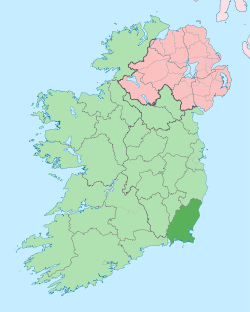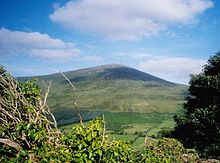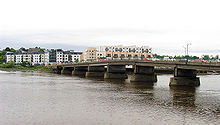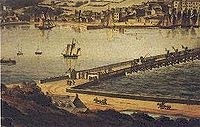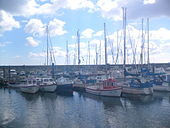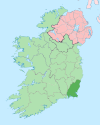- County Wexford
-
County Wexford
Contae Loch Garman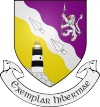
Coat of armsMotto: Exemplar Hiberniae (Latin)
"An example to Ireland"Location in Ireland Coordinates: 52°30′N 6°45′W / 52.5°N 6.75°WCoordinates: 52°30′N 6°45′W / 52.5°N 6.75°W Country Ireland Province Leinster Dáil Éireann Wexford EU Parliament East County seat Wexford Government - Type County Council Area - Total 2,353.2 km2 (908.6 sq mi) Area rank 13th Population (2011) 145,273 - Rank 13th[1] Code WX Website wexford.ie County Wexford (Irish: Contae Loch Garman) is a county in Ireland. It is part of the South-East Region and is also located in the province of Leinster. It is named after the town of Wexford. Wexford County Council is the local authority for the county. In pre-Norman times it was part of the Kingdom of Uí Cheinnselaig, whose capital was at Ferns.[2][3] The population of the county is 145,273 according to the 2011 census.[4]
Contents
Geography and political subdivisions
Wexford is the 13th largest of Ireland’s thirty-two counties in area and 16th largest in terms of population.[5] It is the largest of Leinster’s 12 counties in size and fourth largest in terms of population. The county is located in the south-east corner of the island of Ireland. It is bounded by the sea on two sides—on the south by the Atlantic Ocean and on the east by St. George's Channel and the Irish Sea. The River Barrow forms its western boundary. The Blackstairs Mountains form part of the boundary to the north, as do the southern edges of the Wicklow Mountains. The adjoining counties are Waterford, Kilkenny, Carlow and Wicklow.
Towns and villages
Historical populations Year Pop. ±% 1653 13,004 — 1659 11,680 −10.2% 1821 170,806 +1362.4% 1831 182,713 +7.0% 1841 202,033 +10.6% 1851 180,158 −10.8% 1861 143,954 −20.1% 1871 132,666 −7.8% 1881 123,854 −6.6% 1891 111,778 −9.8% 1901 104,104 −6.9% 1911 102,273 −1.8% 1926 95,848 −6.3% 1936 94,245 −1.7% 1946 91,855 −2.5% 1951 90,032 −2.0% 1956 87,259 −3.1% 1961 83,308 −4.5% 1966 83,437 +0.2% 1971 86,351 +3.5% 1979 96,421 +11.7% 1981 99,081 +2.8% 1986 102,552 +3.5% 1991 102,069 −0.5% 1996 104,371 +2.3% 2002 116,596 +11.7% 2006 131,749 +13.0% 2011 145,273 +10.3% [6][7][8][9][10][11] - Adamstown
- Arthurstown
- Ballycanew
- Ballycullane
- Ballyedmond
- Ballyfadd
- Ballygarrett
- Ballyhack
- Ballymitty
- Ballywilliam
- Bannow
- Blackwater
- Bree
- Bridgetown
- Broadway
- Bunclody
- Camolin
- Campile
- Castlebridge
- Castletown
- Cleariestown
- Clohamon
- Clonroche
- Coolgreany
- Courtown
- Craanford
- Crossabeg
- Cullenstown
- Curracloe
- Duncannon
- Duncormick
- Enniscorthy
- Ferns
- Fethard-on-Sea
- Foulkesmill
- Gorey
- Hollyfort
- Inch
- Killinierin
- Kilmore
- Kilmore Quay
- Kilmuckridge
- Kiltealy
- Monamolin
- Monaseed
- Murrintown
- Monageer
- Newbawn
- New Ross
- Oulart
- Oylegate
- Poulpeasty
- Rathangan
- Rosslare
- Rosslare Harbour
- Raheen
- Rathnure
- Saltmills
- Taghmon
- Watch House Village
- Wellingtonbridge
- Wexford
Climate
Co. Wexford is known as Ireland's "sunny southeast" because, in general, the number of hours of sunshine received daily is higher than in the rest of the country. This has resulted in Wexford becoming one of the most popular places in Ireland in which to reside. The county has a mild, but changeable, oceanic climate with few extremes. The North Atlantic Drift, a continuation of the Gulf Stream, moderates winter temperatures. There is a meteorological station located at Rosslare Harbour.[12] January and February are generally the coldest months, with temperatures ranging between 4–8 °C on average.[13] July and August are generally the warmest months, with temperatures ranging between 12–18 °C on average.[13] The prevailing winds are from the south-west.[14] Precipitation falls throughout the year. Mean Annual Rainfall is between 800–1200 mm.[15] Generally, the county receives less snow than more northerly parts of Ireland. Serious snowfalls are relatively rare, but can occur. The one exception is Mount Leinster, visible from a large portion of the county, which is frequently covered with snow during the winter months. Frost is frequent in winter months, less in coastal areas.
Mountains and hills
Largely low-lying fertile land is the characteristic landscape of the county. The highest point in the county is Mount Leinster (795 m,[16] 2610 ft) in the Blackstairs Mountains in the north-west on the boundary with Co. Carlow.
Other high points:
- Black Rock Mountain, which is 599 m (1,965 ft) high. It is located near the Wexford-Carlow border, within Co. Wexford.
- Croghan Mountain (or Croghan Kinsella) on the Wexford-Wicklow border - 606 m (1,988 ft) high
- Annagh Hill 454 m (1,490 ft), near the Wicklow border
- Slieveboy at 420 m (1,378 ft) high
Notable hills include: Carrigbyrne Hill, Camross (or Camaross) Hill (181 m),[17] Carrigmaistia (167 m),[17] Bree Hill (179 m),[17] Gibbet Hill, Vinegar Hill, Slievecoiltia and Forth Mountain (237 m),[17] and Tara Hill.
Rivers and lakes
The major rivers are the Slaney and the Barrow.
At 192 km (119 mi) in length, the river Barrow is the second longest river on the island of Ireland.[18]
Other smaller rivers of note are the Owenduff, Pollmounty, Corrock, Urrin, Boro, Owenavorragh, Sow and Bann rivers.
There are no significant fresh-water lakes in the county. Small seaside lakes or lagoons exist at two locations – one is called Lady's Island Lake and the other Tacumshin Lake.
Soil
Most, but not all, of the county was covered with the ice sheet during the last Ice age. As the ice retreated, Co. Wexford would have been one of the first areas to be covered with glacial drift (a mixture of boulders, clay, sand and gravel) that blanketed the existing bedrock. This has led to high quality soils, suitable for a wide range of agriculture. A very detailed soil survey of the county was published in 1964, as part of the 'National Soil Survey of Ireland'. It classifies each area of the county according to its specific soil type.[19]
Most of the county is covered with soil called Brown earths, described as well-drained and having a wide use range. After that, Gleys (poorly to imperfectly drained with a limited use range) are the next major soil type, primarily located in the south-east of the county and east of Gorey (along the coast). Gleys are dotted elsewhere around the county in small areas, and where they occur they generally form bogland. The last major soil type is Brown Podzolics, located mainly near the edges of the Blackstairs Mountain range and around Bunclody and in the baronies of East Shelmalier and South Ballaghkeen. Though there are areas covered with other soil types, these are of limited extent.
Flora
Common species of tree include oak, ash, sycamore, alder, blackthorn, hawthorn, beech and birch. Less common (but plentiful) are wild cherry and Scots pine (also called Red Deal). Elm is now far less common, due to the devastating effects of Dutch elm disease. Gorse (or furze) is very common. A priority habitat in Wexford is the grey dune, on which many native wild flora grow, including Bee Orchid and Pyramidal Orchid. Despite the designation of much of this habitat as a Special Area of Conservation, it remains threatened by destruction for agricultural intensification[citation needed]. There is very little natural forest in the county. Most natural trees and vegetation grow on hedgerows.
Fauna
South-eastern Wexford is an important site for wild birds—the north side of Wexford Harbour, the North Slob, is home to 10,000 Greenland White-Fronted Geese each winter (roughly one third of the entire world's population), while in the summer Lady's Island Lake is an important breeding site for terns, especially the Roseate Tern. Grey heron is also seen.
Throughout the county pheasant, wood pigeon and feral pigeons are widespread. Swans, wild duck, kingfisher, and owls (the long-eared owl, the short-eared owl, and the barn owl) are less common - but plentiful. Red grouse, once common, are now extremely scarce. The species has been in decline for some decades. Threats include habitat degradation, disease, predation and over-hunting. Red grouse in Ireland are now considered threatened.[20] The corncrake, also once very common, is now almost never seen. Smaller birds—such as crows, swallows, robins, wrens and so on—are very common. The first magpies in Ireland were recorded by Robert Leigh, of Rosegarland, Co. Wexford, as having appeared in the County of Wexford about 1676.[21][22] Land mammals include badger, rabbit, otter, hedgehog, red fox, mink, bats, squirrel (red and grey squirrel). Rat (brown and black), (It is nearly always the brown rat that is seen; however, the black rat is also occasionally seen in Co. Wexford. Neither is native to Ireland) and mice (the wood (or field) mouse and house mouse). Two types of hare—the Irish (or mountain) hare and the less common brown (or European) hare—are found. Hare is not nearly as common as Rabbit. The stoat (Mustela erminea hibernica) is also reasonably common. Locally the stoat is just as often incorrectly called a weasel.
Only two types of seal are found on Co. Wexford's coast—Atlantic grey seals are very plentiful in coastal areas, but the slightly smaller common (or harbour) seal is less common, yet plentiful. The Small Tortoiseshell butterfly (reddish-orange colour, with black markings) is the most common species of butterfly in the county. Various types of moth are also common. The common frog is plentiful, and is the only type of frog found.
History
The county is rich in evidence of early human habitation.[23] Portal tombs (sometimes called dolmens) exist at Ballybrittas (on Bree Hill)[24] and at Newbawn[25] — and date from the Neolithic period or earlier. Remains from the Bronze Age period are far more widespread.[23] Early Irish tribes formed the Kingdom of Uí Cheinnsealaig, an area that was slightly larger than the current County Wexford. The county was one of the earliest areas of Ireland to be Christianised, in the early 5th century. Later, from 819 onwards, the Vikings plundered many Christian sites in the county.[26] Wexford town became a Viking settlement near the end of the 9th century.[26]
Wexford was the site of the invasion of Ireland by Normans in 1169 at the behest of Diarmuid Mac Murrough, King of Uí Cheinnsealaig and king of Leinster (Laigin), which led to the subsequent colonisation of the country by the Anglo-Normans.
The native Irish began to regain some of their former territories in the 14th century, especially in the north of the county, principally under Art MacMurrough Kavanagh. Under Henry VIII the great religious houses were dissolved, 1536–41; in Co. Wexford this included Glascarrig Priory, Clonmines Priory, Tintern Abbey, and Dunbrody Abbey.
On 23 October 1641, a major rebellion broke out in Ireland, and Co. Wexford produced strong support for Confederate Ireland. Oliver Cromwell and his English Parliamentarian Army arrived 1649 in the county and captured it. The lands of the Irish and Anglo-Normans were confiscated and given to Cromwell's soldiers as payment for their service in the Parliamentarian Army. At Duncannon, in the south-west of the county, James II, after his defeat at the Battle of the Boyne, embarked for Kinsale and then to exile in France.
Co. Wexford was the most important area in which the Irish Rebellion of 1798 was fought, during which significant battles occurred at Vinegar Hill (Enniscorthy) and New Ross. The famous ballad Boolavogue was written in remembrance of the Wexford Rising. At Easter 1916, a small rebellion occurred at Enniscorthy town, on cue with that in Dublin.[27] During World War II, German planes bombed Campile.[28][29] In 1963 John F. Kennedy, then President of the United States, visited the county and his ancestral home at Dunganstown, near New Ross.
Local government
Wexford County Council has twenty-one members. The Wexford constituency is represented by five deputies in Dáil Éireann: John Browne (FF), Paul Kehoe (FG), Brendan Howlin (Lab), Liam Twomey (FG) and Mick Wallace (Ind)
Culture
Since 1951, an opera festival, Wexford Festival Opera, takes place every year in the Theatre Royal in Wexford town and runs for several weeks.[30] A new Opera House has recently replaced the old one on the same site, it is now called Wexford Opera House. The new theatre opened in 2008.
There is a renowned singing tradition in County Wexford. Having an abundance of traditional songs, many of which relate to the rebellion of 1798, the county has for many years had a strong presence in the Irish traditional singing scene. Noted singers include All-Ireland Fleadh Champions Paddy Berry, Seamus Brogan and Niall Wall. Paddy Berry has also collected and published a number of songs from Wexford.
Beaches in Curracloe, Co. Wexford were used to film the opening scenes of the movie Saving Private Ryan, which depicted the D-day assault on Omaha Beach. The Count of Monte Cristo, directed by Kevin Reynolds, was partly filmed in the village of Duncannon in 2000 — Duncannon Fort being used for one of the main scenes.[31]
Media
- There are two radio stations based in the county, South East Radio[32] and Beat FM.[33]
- The county's main newspapers include Wexford People, New Ross Standard, Gorey Guardian, and Enniscorthy Echo.
Places of interest
The scenic Bannow Drive, popular amongst tourists, is a signposted route through four Wexford villages: Duncormick, Cullenstown, Bannow and Wellingtonbridge.
Ballyteigue Burrow, located near Duncormick, is one the finest protected sand dune systems in Ireland. Rich in wildflowers, wildlife and butterflies, this 9 km coastal stretch is a protected nature reserve by the golden sands of Ballyteigue Bay, with spectacular scenery.
The Hook Peninsula is noted for its many beaches and spectacular scenery. It features the medieval Hook Head lighthouse and the historic townland of Loftus Hall.
Popular beaches are located at Courtown, Curracloe, and Duncannon.
Other places of interest include:
- Ferns Castle and Abbey[34]
- Enniscorthy Castle and Museum
- Vinegar Hill
- National 1798 Visitor Centre[35]
- Boolavogue
- The Browne-Clayton Monument
- Oulart Hill
- Castleboro House [36]
- The Seven 'Castles' of Clonmines
- Johnstown Castle
- Ballyteigue Castle
- Bannow Church (dates from 13th century)
- Selskar Abbey, Wexford town
- Irish National Heritage Park (Ferrycarrig)
- Tacumshin windmill (southeast Co. Wexford)
- St. Mary's Church (New Ross)
- Dunbrody Abbey
- Tintern Abbey[37]
- Slade Castle
- Ballyhack Castle
- J.F. Kennedy homestead and park
- Slieve Coilte
- Duncannon Fort
Economy
Agriculture
The economy is chiefly agricultural. Cattle, sheep, pig rearing and some horse breeding are the main types of husbandry practiced. Poultry rearing, once popular, has very much declined. Wheat, barley, rapeseed, and oats are grown, as are potatoes. Sugar beet is no longer grown due to the withdrawal of EU subsidies. The numbers involved in farming have been declining for many years and many of the seasonal workers are now eastern Europeans. Mushrooms are also grown indoors. Tomatoes are grown under glass, for example at Campile. Wexford strawberries are famous and can be bought in shops and wayside stalls throughout the summer. Every year, near the end of June, a 'Strawberry Fair' Festival takes place in the town of Enniscorthy, and a Strawberry Queen is crowned. Dairy farming forms an important part of the agricultural industry. Locally produced milk is on sale in many supermarkets. Wexford Irish Cheddar is an award-winning brand, and Carrigbyrne, a full-flavoured soft cheese, is produced near New Ross.
Forestry
Evergreen tree species are extensively cultivated, especially in more recent years—Norway Spruce and Sitka Spruce are the most common varieties planted. These are generally sown on poorer quality soils (mainly in bogs and on hills or mountainsides). A small amount of deciduous trees are also planted, though these require better soils.
Mining
Silver was once mined at Clonmines—primarily in Tudor times. Lead was mined at Caim, 1818-c1850—this mine also contains zinc; the two are usually found together. Copper ore (Malachite) is found at Kerloge, just south of the town of Wexford. Iron is found in small quantities at Courtown Harbour. The county is not noted for mineral reserves. No significant mining activity is currently practised, with the exception of quarrying for stone. In 2007, a significant oil find was made 60 kilometres off Hook Head in Co Wexford.[38]
Energy
 Ballywater Wind Farm, near Kilmuckridge - the largest wind farm in Co. Wexford (consisting of 21 wind turbines).
Ballywater Wind Farm, near Kilmuckridge - the largest wind farm in Co. Wexford (consisting of 21 wind turbines).
Carnsore Point made the national headlines in the late 1970s after a proposal was made to build a nuclear energy plant there; the plans were abandoned after extensive protests from the public, due to environmental and health concerns.[39] A wind farm has now been built on the site, featuring 14 wind turbines generating electricity. It was completed in November 2002 and was the first wind farm on the east coast of Ireland. Wind farms now exist at a few other locations in the county, such as Ballywater Wind Farm, at Cahore (near Kilmuckridge), on the county's east coast, and Richfield wind farm, located in the southeast of the county.
Great Island Power Station opened in 1967 and was operated by the Electricity Supply Board (ESB) until it was sold to Endesa in January 2009.[40] It is an electricity-generating station fueled by heavy fuel oil and rated at 240 MW.[41] It is located at the confluence of the rivers Barrow and Suir, near Campile. Before its sale, the station was scheduled to close by 2010.[42][43] Endesa propose building a 430 MW combined cycle gas turbine (CCGT) gas fired plant on the site.[41] The project would need a new 44.5 km gas pipepline from the existing transmission network at at Baunlusk, 6 km south of Kilkenny City.[44]
Transport
- Road: Recent years have seen a major upgrading of the county's main roads.
- Bus: Rosslare and Dublin are also linked by Bus Éireann route 2,[45] while route 5 operates Waterford-New Ross-Enniscorthy-Dublin.[46]
- Rail: The Rosslare–Dublin railway line runs through the county, serving Rosslare Europort, Rosslare Strand, Wexford, Enniscorthy and Gorey. Three trains run in each direction daily, with additional commuter services from Gorey. The Rosslare–Limerick railway line runs through the southern part of the county, serving Bridgetown, Wellington Bridge, Ballycullane and Campile.
- Ferry: Rosslare Europort, located at Rosslare Harbour, operates a busy Ferry service. There are regular sailings to Wales (Pembroke and Fishguard) and France (Cherbourg, Roscoff and Le Havre) for passengers and vehicles. There is also ferry service in operation between Ballyhack and Passage East (Co. Waterford), crossing the Barrow estuary.
Sport
Gaelic games
GAA is very popular in the county, which is noted most for hurling. Wexford last won the All-Ireland Senior Hurling Championship in 1996, beating Limerick in the final. However, there has been a rapid decline since then in terms of success. In recent years the county Football team has been making rapid advances. Camogie, a women's version of hurling, is also played, and Wexford won the All Ireland in 2007 and 2010. Wexford Park is the county's main GAA pitch. Also, handball is played on a limited basis; there are a number of handball alleys located throughout the county.
Soccer
Wexford Youths F.C., recently formed, is the major soccer club in the county, currently playing in the League of Ireland First Division.
Golf
There are numerous golf clubs in the county - including Rosslare (a Links course),[47] and Enniscorthy.[48] Two more are located near Gorey - Ballymoney Golf Club and Courtown Golf Club - both 18-hole courses.[49] Bunclody Golf and Fishing Club, boasting Europe's only golf lift, is situated just inside County Carlow.[50] There are also a few others. New Ross Golf Club, however, is actually located in County Kilkenny - about 1 km from New Ross town.[51]
There are also many par-3 courses in the county, such as Scarke Golf Course & Driving Range,[52] located about 2 km east of New Ross town, the 'Abbey Par 3' course, at Winningtown, Fethard-on-Sea, Blackwater Par 3 Golf Course,[53] Kilnew, Blackwater, located a few kilometres northeast of Wexford town, Garrylough Golf Course and Driving Range, Screen, and Rathaspeck Manor Golf Course, Rathaspeck, near Rosslare (there are also few Par-4 holes on this course). There are also a number of other Par-3 courses in the county.
Fishing
Much maritime activity takes place - especially at Kilmore Quay and Slade, but also on a smaller scale at many other locations. Common fish species include herring, mackerel, cod, monkfish, whiting, bass, perch, gurnard, haddock, mullet, pollock, John Dory, sole, conger eel, shad, salmon, trout, pike, carp, and tench. Shellfish include mussels, cockles, periwinkles, clams, and oysters.
Racing
Wexford Racecourse (horse racing) is located at Wexford town[54] and there is a Greyhound Racing track at Enniscorthy.[55]
People
- Patrick Nicholas Bolger - Captain, Irish Merchant Navy, received medal from Soviets for bringing supplies to Russia during WWII through waters filled with Nazi U-boats
- John Barry - Commander United States Navy.
- John Banville - journalist and author (winner of the Man Booker Prize in 2005).
- Paddy Berry - singer, song collector and folklorist.
- Wallis Bird - musician.
- Myles Byrne - participant in the Irish Rebellion of 1798.
- Thomas Cloney - participant in the Irish Rebellion of 1798.
- John Henry Colclough – participant in the Irish Rebellion of 1798
- Eoin Colfer - best-selling children's author.
- Brendan Corish - Irish Labour Party leader and Tánaiste.
- Francis Danby - 19th century painter.
- Pádraic Delaney - actor.
- Anne Doyle - RTÉ newsreader.
- Kevin Doyle - soccer player.
- John French - maternal grandfather of George Harrison
- Nicholas French - former RC Bishop of Ferns.
- Nicholas Furlong - author, journalist and historian.
- Edward Hay - author of a history of the Irish Rebellion of 1798.
- Beauchamp Bagenal Harvey - participant in the Irish Rebellion of 1798.
- Herbert Hore - historian.
- Patrick Kennedy - great-grandfather of John F. Kennedy (former president of the United States).
- Father John Murphy - participant in the Irish Rebellion of 1798.
- Aidan O'Brien - horse trainer.
- Michael O'Hanrahan - Irish rebel executed for fighting in the 1916 Easter Rising.
- Nicky Rackard - hurling player.
- John Redmond - 19th/20th century nationalist politician.
- Billy Roche - playwright.
- Dick Roche - politician.
- James Ryan - politician and Irish Revolutionary.
- Martin Storey - hurling player.
- Colm Tóibín - Booker Prize-nominated author.
- Michael Balfe - 19th century composer, grew up in Wexford.
- Major G. E. H. Barrett-Hamilton - zoologist, grew up in Kilmanock
- Des Bishop - London-born comedian, based in Co. Wexford.
- Chris de Burgh - Argentinian-born singer-songwriter, based in Co. Wexford.
- Anna Maria Hall (Mrs. S.C. Hall) - 19th century novelist, raised in Bannow.[56]
Demographics
In 2006 the county had a total population of 131,749 people. Of these, 65.4% (86,137 people) lived in rural areas and 34.6% (45,612 people) lived in urban areas.[57] 35.5% of the county's population (46,768 people) were aged under 25 years and 11.6% of its population (15,324 people) were aged over 65 years.[58] 89.8% of the county's population stated their religion as Roman Catholic, almost 4% as Protestant, including Church of Ireland, and 3% stated they had no religion. Other religions made up the remainder.[59] Between 2002 and 2006, the population of County Wexford increased by 13% (15,153 people).[60]

County Wicklow 
County Kilkenny and County Carlow 
Irish Sea  County Wexford
County Wexford 

Celtic Sea See also
- List of towns and villages in Ireland
- List of abbeys and priories in Ireland (County Wexford)
- Lord Lieutenant of Wexford
- High Sheriff of Wexford
References
- ^ Census 2006 — Volume 1 - Population Classified by Area (Dublin: Stationery Office, 27 April 2007)PDF (4.22 MB) – Central Statistics Office (Ireland). Retrieved on 2008–05–16.
- ^ Furlong, p. 18.
- ^ Byrne, Irish Kings and High Kings, pp 130–164.
- ^ Census 2006 - Population of each province, county and city
- ^ Corry, Eoghan (2005). The GAA Book of Lists. Hodder Headline Ireland. pp. 186–191.
- ^ For 1653 and 1659 figures from Civil Survey Census of those years, Paper of Mr Hardinge to Royal Irish Academy March 14, 1865.
- ^ Census for post 1821 figures.
- ^ http://www.histpop.org
- ^ http://www.nisranew.nisra.gov.uk/census
- ^ Lee, JJ (1981). "On the accuracy of the Pre-famine Irish censuses". In Goldstrom, J. M.; Clarkson, L. A.. Irish Population, Economy, and Society: Essays in Honour of the Late K. H. Connell. Oxford, England: Clarendon Press.
- ^ Mokyr, Joel; O Grada, Cormac (November). "New Developments in Irish Population History, 1700-1850". The Economic History Review 37 (4): 473–488. doi:10.1111/j.1468-0289.1984.tb00344.x. http://www3.interscience.wiley.com/journal/120035880/abstract.
- ^ Rosslare MET Station.
- ^ a b "Climate - 30 Year Averages – Rosslare MET Station - monthly and annual mean and extreme values (1961-1990)". MET ÉIREANN Website. http://www.met.ie/climate/rosslare.asp. Retrieved 2008-05-14.
- ^ "Climate - Wind". MET ÉIREANN Website. http://www.met.ie/climate/wind.asp. Retrieved 2008-05-15.
- ^ "Climate - Rainfall – & Map (Mean Annual Rainfall (mm) 1961-90)". MET ÉIREANN Website. http://www.met.ie/climate/rainfall.asp. Retrieved 2008-05-15.
- ^ The Times Atlas of the World, p. 107 (Map - Ireland).
- ^ a b c d OSI, Discovery Series 77.
- ^ "FAQ - Longest Rivers in Ireland". Ordnance Survey Ireland (OSi) Website. http://www.osi.ie/mapping/FAQ/longRivers.shtml. Retrieved 2008-05-19.[dead link]
- ^ Gardiner, M.J. & Pierce Ryan. Soils of Co. Wexford. Dublin: An Foras Talúntais, 1964.
- ^ [1] [2]
- ^ Herbert F. Hore (ed.), "A Chorographic Account of the Southern part of the County of Wexford, written Anno 1684, by Robert Leigh. Esq., of Rosegarland, in that County" in "The Journal of the Kilkenny and South-East of Ireland Achaeological Society" (Dublin, 1859), p. 467.
- ^ See William Thompson, "The Natural History of Ireland", Vol. 1 - (London, 1849), p. 328, for further details - other historical accounts mentioned here confirm Leigh's statement.
- ^ a b Stout, Geraldine. "Essay 1: Wexford in Prehistory 5000 B.C. to 300 AD" in Wexford: History and Society, pp 1 - 39.
- ^ "Ballybrittas Portal Tomb (with Photo) - well preserved". Megalithomania.com. http://www.megalithomania.com/show/image/2148/Ballybrittas.htm. Retrieved 2008-05-16.
- ^ "Newbawn Portal Tomb (with Photo) – badly dilapidated". Megalithomania.com. http://www.megalithomania.com/show/image/7881/Newbawn.htm. Retrieved 2008-05-16.
- ^ a b Annals of the Four Masters (A.F.M.)
- ^ Furlong and Hayes, pp 46 - 70.
- ^ Furlong, p. 143.
- ^ "Bombing of Campile remembered". Wexford People. 1 September 2000. http://www.wexfordpeople.ie/news/bombing-of-campile-remembered-992708.html. Retrieved 2008-05-21.
- ^ Wexford Opera Website.
- ^ "Count of Monte Cristo comes to Duncannon". Wexford People. 28 August 2008. http://www.wexfordpeople.ie/news/count-of-monte-cristo-comes-to-duncannon-992630.html. Retrieved 2008-07-18.
- ^ South East Radio's Website
- ^ http://www.beat102103.com/ Beat 102-103's official website
- ^ "Ferns Castle". Heritage Ireland website. http://www.heritageireland.ie/en/South-East/FernsCastle/. Retrieved 2008-05-15.
- ^ "National 1798 Visitor Centre". National 1798 Visitor Centre Website. http://www.iol.ie/~98com/. Retrieved 2008-05-15.
- ^ "Castleboro House, burned 1923". Abandoned Ireland. http://www.abandonedireland.com/castleboro.html.
- ^ "Dunbrody Abbey". Dunbrody Abbey Visitors Centre Website. http://www.dunbrodyabbey.com. Retrieved 2008-05-16.
- ^ "Irish firm reports 'significant' oil find off Hook Head". Irish Independent. 10 October 2007. http://www.independent.ie/breaking-news/national-news/business/irish-firm-reports-significant-oil-find-off-hook-head-1139280.html. Retrieved 2008-05-10.
- ^ "Remembering Carnsore crusade". Wexford People. 12 September 2001. http://www.wexfordpeople.ie/news/remembering-carnsore-crusade-989861.html. Retrieved 2008-05-19.
- ^ Slattery, Laura (2011-02-26). "Spanish energy firm Endesa putting Irish unit up for sale". Irish Times. http://www.irishtimes.com/newspaper/finance/2011/0226/1224290925445.html. Retrieved 2011-11-01.
- ^ a b "Endesa Ireland - Great Island Power Project - Project Description". Endesa. http://greatislandpowerproject.com/project-description.html. Retrieved 2011-11-01.
- ^ "Great Island generating station". ESB Website. Archived from the original on 2008-04-18. http://web.archive.org/web/20080418143808/http://www.esb.ie/main/about_esb/powerstations/greatisland/home/index.jsp. Retrieved 2008-05-10.
- ^ "No more smoke from chimneys". New Ross Standard. Wednesday, 30 April 2008. http://www.newrossstandard.ie/news/no-more-smoke-from-chimneys-1364731.html. Retrieved 2008-05-10.
- ^ "Great Island pipeline plan". New Ross Standard. 2011-11-01. http://www.newrossstandard.ie/news/great-island-pipeline-plan-2922497.html. Retrieved 2011-11-01.
- ^ http://www.buseireann.ie/site/your_journey/printed_timetable_pdfs/expressway/2.pdf
- ^ http://www.buseireann.ie/site/your_journey/printed_timetable_pdfs/expressway/5.pdf
- ^ Rosslare Golf Club (18 holes).
- ^ Enniscorthy Golf Club (18 holes).
- ^ Courtown Golf Club website.
- ^ Bunclody Golf & Fishing Club website
- ^ Location map on New Ross Golf Club website.
- ^ Scarke Golf Course & Driving Range website.
- ^ Blackwater Par 3 Golf Course website.
- ^ "Wexford Racecourse". http://www.wexfordraces.ie/. Retrieved 2008-05-10.
- ^ "Enniscorthy Greyhound Track". Irish Greyhound Board website. http://www.igb.ie/stadia/enniscorthy/. Retrieved 2008-05-10.
- ^ Anna Maria Hall biography on the Princess Grace Irish Library (Monaco) website
- ^ Census 2006, Volume 1, p. 19.
- ^ Census 2006, Volume 2 - Ages and Marital Status, pp 18-19.
- ^ Census 2006, Volume 13 - Religion, p.27.
- ^ Census 2006, Volume 1, p. 13.
Bibliography
- Byrne, Francis J. Irish Kings and High Kings. Dublin, 1973–2001
- Carlyle, Thomas. "Oliver Cromwell's Letters and Speeches". Vol. 1. New York: Wiley & Putnam, 1845
- Cambrensis, Giraldus. Expugnatio Hibernica - The Conquest of Ireland. Dublin: R.I.A., 1978
- Colfer, Billy. The County of Wexford. Co. Wexford: Foillsitheoirí Cois Sláine, n.d. - 1980 or 1981.
- Furlong, Nicholas. A History of County Wexford. Dublin: Gill & MacMillan, 2003. ISBN 0-7171-3461-X
- Furlong, Nicholas and John Hayes. County Wexford in the Rare Oul' Times Vol. IV. 1910-1924. Wexford: Old Distillery Press, 2005. ISBN 0-9512812-3-2
- Ordnance Survey Ireland (OSi). Discovery Series 77 - Co Wexford (part). Scale 1: 50,000. Dublin: OSI, Phoenix Park, 1997. ISBN 0-904996-71-9
- The Times Atlas of the World – Reference Edition. London: Times Books, 1995-2002. ISBN 0-00-712400-7
- Whelan, K.(ed) & W. Nolan (assoc. ed.). Wexford: History and Society. Dublin: Geography Publications, 1987
External links
Places in County Wexford County town: Wexford Towns Bunclody · Courtown · Enniscorthy · Ferns · Fethard-on-Sea · Gorey · New Ross · Wexford
Villages and
TownlandsAdamstown · Arthurstown · Ballycanew · Ballycullane · Ballyedmond · Ballygarrett · Ballyhack · Ballywilliam · Bannow · Blackwater · Bree · Bridgetown · Broadway · Camolin · Campile · Castlebridge · Castletown · Cleariestown · Clohamon · Clonroche · Coolgreany · Craanford · Crossabeg · Cullenstown · Curracloe · Duncannon · Duncormick · Foulkesmill · Hollyfort · Inch · Killinierin · Kilmore · Kilmore Quay · Kilmuckridge · Kiltealy · Monamolin · Monaseed · Murrintown · Monageer · Newbawn · Oulart · Oylegate · Poulpeasty · Rathangan · Rosslare Strand · Rosslare Harbour · Raheen · Rathnure · Saltmills · Taghmon · Watch House Village · Wellingtonbridge
List of townlands in County Wexford · Category:Mountains and hills of County Wexford · Category:Rivers of County Wexford · Category:Geography of County Wexford Counties of Ireland The counties are listed per province Connacht Munster Clare · Cork (Cork City) · Kerry · Limerick (Limerick City) · Tipperary (North Tipperary • South Tipperary) · Waterford (Waterford City)
Leinster Carlow · Dublin (Dublin City • Dún Laoghaire–Rathdown • Fingal • South Dublin) · Kildare · Kilkenny · Laois · Longford · Louth · Meath · Offaly · Westmeath · Wexford · Wicklow
Ulster Italics denote non-administrative counties. Brackets denote eponymous cities or non-traditional counties. † denotes counties of Northern Ireland Categories:- County Wexford
- Leinster
- Counties of the Republic of Ireland
- Local administrative units of the Republic of Ireland
Wikimedia Foundation. 2010.

